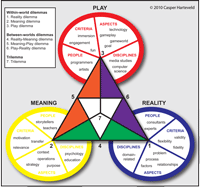

In a nutshell, Triadic Game Design (TGD) puts forward (see the figure-click to view it):
- that the design of a game poses a multi-objective problem in a design space involving three equally important worlds: Reality, Meaning, and Play;
- A game needs to be related to the domain and subject for which the game is developed (Reality);
- A game needs to attain a value beyond the game itself (Meaning);
- A game needs to have elements that characterize play and make it a powerful tool to use (Play);

- that each world has its own people, disciplines, aspects, and criteria on how to design a game;
- that various tensions can arise within and between the three worlds, forcing designers to make trade-offs;
- that it is fundamental to keep these three worlds in balance to create a "good" game-a game that accomplishes its meaningful purpose;
- that a balance can be achieved by designing the core of the game concurrently-by taking different design problems and various perspectives at the same time into account;
- that an eventual "optimum" is found when the design is satisficing in accordance with the criteria of the worlds of Reality, Meaning, and Play.




